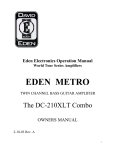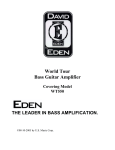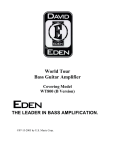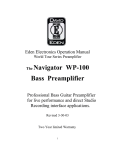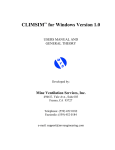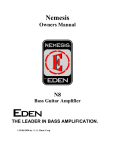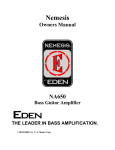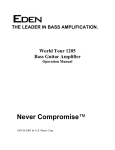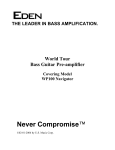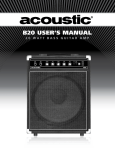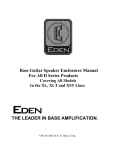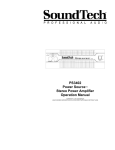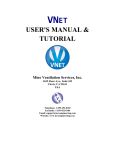Download Eden WT-405 Time Traveler Owner`s manual
Transcript
WT-405 Time Traveler Bass Guitar Amplifier Owner’s Manual 12/20/04 1 Forward Congratulations on your purchase of the Eden Time Traveler Bass Instrument Amplifier. You have purchased what we feel is one of the finest bass amplifiers in the world. The Time Traveler produces 405 watts of pure power into 4 ohms (250 watts into 8 ohms and 655 Watts into 2 Ohms ) with 3db of dynamic headroom. The new pre-amp. Section, with its familiar Eden enhance control, and powerful new 3 way tone control system are coupled to a studio quality compressor. The new Auto Booster for low and high frequencies, along with a mid shifter, tone bypass, selectable DI, selectable distortion, and a gentle autocompression circuit allow you to achieve a wide array of sounds. This compact, rack mountable package houses modular circuits made with superior components and designed for years of trouble-free service. Thank you for choosing Eden. Please take the time to review this manual and to send in your warranty registration card. CAUTION! Your ears are your most important piece of equipment. Unfortunately, they cannot be replaced as easily as your other gear. Please take the following warning seriously. This product, when used in combination with a sound source and loudspeakers or headphones, may be capable of producing sound levels that could cause permanent hearing loss. DO NOT operate at high volume levels or at a level that is uncomfortable. DO NOT place your ears next to the speakers. If you experience any discomfort or ringing in the ears or suspect hearing loss, you should consult a health care professional. Please complete for your records: Date of Purchase: __________________________ Model: ___________________________________ Serial Number: _____________________________ Dealer: ___________________________________ 2 Label1 FRONT PANEL FEATURES Input Jacks – Designed to accept a simultaneously boosts the very low bass, upper middle, and high frequencies while putting a dip in the lower middle frequencies. It is flat when set to its minimum level. standard ¼ inch mono phone plug. For best results use a high-quality shielded cable to connect your instrument to the amplifier. Both inputs are buffered and will handle standard, high level and piezo input signals. They can be used simultaneously Tone Control Section Mute switch – Mutes all outputs except you to boost or cut the tone at the desired frequency. The spacing allows the controls to interact smoothly and musically. the tuner output. The indicator lights when Mute is on. Tone Control – These three controls allow . D.I. Selector - Selects the D.I. send in either the Pre or Post tone position. Bass – This traditional shelving tone control Input Gain Switch – By pushing the Gain provides 15 dB of boost or cut at approx. 30 Hz. The control is flat in the 12:00 position. switch in, you engage a +10db gain Boost. For low gain instruments use the Gain switch in the high Gain position. Hi Gain Indicator LED– Lights to indicate that the unit is in the high gain position. Warm Switch- This switch engages the positive half wave tube style distortion circuit. The distortion effect is increased by adding more input gain. Warm Trim- Located behind the front panel . Use a small screw driver to adjust the level of the effect. Gain Control – Regulates the first gain stage of the preamplifier and controls the amount of signal available to the system. Mid Range Control- This covers the central portion of the sound envelope and can be critical to getting your sound right. The body of the Bass sound is in the mid range. Mid Shift Control – Provided to shift the midrange control from low mid (550Hz) for general playing and recording to the high mid position (2.2K) for Rock and more aggressive tones. Tone Bypass Control– Located beneath the tone control. A great tool for recording. This bypasses the tone section only and does not effect the boosters or the compressor. Treble – This is a traditional shelving-type clipping anywhere in the system. This should never be lit up. tone control. It provides 15 db of boost or cut. The knee of the filter is at approximately 2KHz. The control is flat at the 12: 00 position. Compressor Control- This adjusts the threshold level of the compressor. The ratio is fixed at an optimum point for Bass reproduction. Master Level Control – Adjusts overall system output and stage loudness. Compressor Indicator – Lights to Headphone Jack – It accepts a standard ¼ stereo or mono headphone plug. It can also be used as a Master output send to slave another amplifier. Output Limit Indicator – Lights to indicate activity of the power amplifier limiting circuit, which protects the speaker system from severe distortion. This LED indicates that the amplifier has reached its maximum output level. Clip Indicator – Flashes to indicate indicate that the signal has crossed the threshold of the compression circuit and that compression is taking place. Compressor Bypass – Turning the Compressor Control off will disengage the compressor. Enhance Control – Called the “Magic Knob” by some, this complex control 3 Mains On/Off Switch – This switch turns the system power on or off. The switch illuminates to indicate the presence of AC power present in the chassis. This switch is prior to the fuse. The switch light can be on even if the fuse is blown The light in the switch may flicker depending on local voltage conditions. This is normal and nothing to be concerned about Speaker On/Off Switch- This switch turns off the loudspeaker out put jacks . REAR PANEL FEATURES Combination Power Cord Jack and Fuse Holder – The removable power cord is attached here. Pulling the holder out of the top of the power inlet accesses the fuse carrier. Your unit was shipped with a spare fuse inserted in the fuse carrier. USE ONLY THE SAME SIZE AND TYPE FOR REPLACMENT. Models come with a holder marked (FUSE) they are factory configured for 100/120/ 230/240 only and must be adapted by a service tech for any voltage change. The standard fuse for U.S. use is (5) Amp slow blow or time delay. Do not use fast blow fuses. Amp Outs – These consist of two ¼ inch jacks and a NL-4 connector. The jacks are wired in parallel. The total speaker load impedance should not exceed 4 ohms. Amplifier Power Rating: 250 Watts RMS @ 8 Ohms 405 Watts RMS @ 4 Ohms 655 Watts RMS @ 2 Ohms Mono Pre Tone Effects Send/Return – These standard ¼ jacks allow you to send and receive your signal to and from external devices. The effects loop is positioned post (behind) the compressor before the enhance control and the tone section. Recording Out – This fully balanced XLR output allows you to send a pre or postEQ/pre-master signal to a recording or sound reinforcement mixing console. This output is designed to use with phantom powered systems. D.I. Level – Controls the level being sent from the XLR balanced output jack. Ground Lift Switch – This switch lifts the ground within the balanced output system to allow you to eliminate excessive noise when connected to external systems. Stereo Aux. Input - The standard ¼ mono jack is designed to accept the signal from an external source such as a CD or cassette player, drum machine, synth. module, etc. The signal is summed prior to the master volume control. The signal enters the system before the tone controls. These jacks can also be used to return a studio cue signal, allowing the Time Traveler to provide you with your own headphone mix in the studio. Amplifier Break Link-These are provide to break the signal chain at the input to the amplifier. This can be used as an insert point or control point for the final amplifier Tuner Out Jack – This standard ¼ inch jack is designed to provide a pre-gain signal for connection to a tuner. It can also be used to provide pre-tone signal to other devices such as a direct box or console. The signal is 2X input. Cooling System – Your amplifier features a thermostatically controlled fan, which will switch on when the internal temperature reaches 130 degrees F. In low volume situations (into 8 Ohm loads) the fan may not come on at all. The system also features a high temperature thermal safety system which will activate an AGC circuit if the operating temperature goes above 190 degrees F. This circuit will automatically turns down the output of the system in the event of overheating. It will automatically reset itself to full power as soon as the unit cools down to a safe operating temperature. Usually it takes from 2 to 5 minutes before the unit will begin to operate normally again. (Note: the D.I. will continue to operate normally even when the amplifier is in thermal shut down. Only the stage sound will be lost.) 4 OPERATING INSTRUCTIONS MECHANICAL AND THERMAL ISSUES – Your amplifier should always be placed for operation away from sources of moisture or heat. Care should be taken not to obstruct the ventilation holes on the bottom and sides of the unit. In the event of thermal shutdown, you should eliminate the cause of the thermal problem (poor ventilation, speaker loads lower than 2 ohms) immediately. The supplied rack ears can be used to install your amplifier in a conventional equipment rack for protection during transportation. ELECTRICAL CONNECTION – The Time Traveler requires at least 10 Amps of correctly wired alternating current for proper operations. CONNECTIONS – All line connections (everything but the speakers) should be made with high-quality shielded cables. The use of speaker cables for line connections will result in excess noise. Speaker connections should be made with highquality 16 gauge or larger unshielded speaker cables. We recommend 10 or 12 gauge cables. The use of shielded line or instrument cables for speaker connections can damage your amplifier. The speaker cable should be as short as possible. TURN ON – We recommend turning your system on with the master volume control set to its minimum position. This will prevent any unexpected signal from being sent to your speakers. SETTING YOUR LEVEL – Effective use of the gain control will ensure the best signal-to-noise ratio. The Compressor, and EQ Clip indicators are all provided to assist you in setting your level correctly. You should begin the process with your master control set to a low, or off position, and your tone controls set flat. While playing your instrument normally, bring the gain control up to about 11:00 . Set the compressor light so that it winks on the peaks that result from your strongest normal attack. This will generally show up most on your lower strings. If more compression is desired, increase the control so the compressor light comes on more readily. Having set your initial level, you are now ready to proceed with setting up your tone controls. Since tone adjustments have an impact on the overall preamp gain level, you may well need to return to the gain control and repeat this process once you have completed your EQ adjustments. SETTING UP YOUR EQ Begin with all tone controls set flat and with the Enhance Control set to its minimum position. After setting your Gain level, bring the Master control up to a moderate level. Slowly bring the Enhance control up, playing as you make each adjustment. Many players find that there is a small amount of boost on the Enhance control that will get them very close to the sound they are after. If it doesn’t, return it to its minimum or 0 position. Overall bass and treble adjustments can be made with the Bass and Treble controls. These controls cover a fairly broad range of the frequency spectrum. Many players use these controls to compensate for acoustic situations, relying on the Enhance and Parametric controls to achieve their basic sound. Adjusting the mid range control will bring you either more up front in the mix or more in the background The frequencies that you will need to boost or cut are dependent upon your instrument, playing style, speaker cabinets, and venue. Extreme settings of boost or cut are unlikely to be necessary or helpful. We are frequently asked to provide suggested settings for various styles of play. We have discovered though, that most of our endorsers tend to set their EQ generally flat, using varying amounts of the Enhance Control. We encourage you to experiment with different settings to obtain the sound you desire. We have included some EQ panel diagrams at the back of this manual to help you record your settings. Clip Light – This indicator will flash if clipping occurs in the EQ section of the preamp. This can be remedied by decreasing the amount of boost in the EQ 5 section or by decreasing the Gain control. This light should never be on while playing. Other EQ Considerations – If you find yourself running out of amplifier headroom, cut a little in the lower frequencies, which require the most power from your amp. Two areas are a frequent source of frustration for bassists trying to achieve their sound: frequency masking and frequency enhancement. Frequency masking occurs when other instruments (particularly cymbals and electric guitars) obscure the important upper harmonic content of your sound. As a result, you find that the EQ settings that were so perfect at home lack definition in a live setting. On the other hand, the stage settings that worked so well sound harsh and/or thin in the absence of other instruments. Frequency enhancement results from cabinet placement and room acoustics. A cabinet placed on the floor will have the lower frequencies boosted by about 3 db. Placement against a wall adds another 3 db. A corner adds 3 db more. Consequently you may find a surprising boominess to your sound. Certain qualities in the room itself can also enhance the lower frequencies, further contributing to this problem. Frequently this effect is more noticeable in the audience than it is on stage. Compensating for it may result in a stage sound that may seem a little thin. However the sound is actually quite full out in front. OTHER CONSIDERATIONS Suggested Speaker Systems – Your speaker system, should be chosen to accommodate the characteristics of your amplifier and your predominant application. If you will only be using one cabinet per side, a 4 Ohm model will draw the most current from your amplifier. If you will generally be using two cabinets, they should both be 8 Ohm models so their combined impedance will be 4 ohms. If you are uncertain about your future needs always go with the 8 Ohm speaker option so that you can add another speaker later if you need to. Headphone Jack as a Line Driver – On some occasions (such as high-volume or outdoor situations) it may be desirable to use the Time Traveler along with an additional power amplifier and added cabinets. A standard shielded instrument cable may be used to connect from the headphone jack of the unit to an unbalanced input of a standard power amplifier. This will provided a signal that is post EQ and master volume controls, allowing the entire system to be controlled from the Time Traveler. Using the Time Traveler With out Speakers -This amplifier is designed to be used safely with headphones only, without the loud speaker plugged in. No harm will result from using the amplifier in this fashion. This allows the use of the unit for practice with headphones and as a preamplifier with other amplifiers. MAINTENANCE Your Eden amplifier has been designed to require minimal routine maintenance. Attention to the following areas will ensure optimum performance of your amplifier. Contact Point Cleaning – One of the weakest links in most bass amplification systems are the solderless connection points where instruments, speaker cabinets, effects, and other devices are connected to the amplifier. (The most vulnerable of these types of connection is the jack on your instrument). In addition to contamination from airborne pollutants, these points are frequently assaulted by connectors that have picked up debris from dirty stages, cases, etc. These points should be cleaned regularly with a cotton swab soaked in denatured alcohol or a commercially available de-oxidant. Frequent cleaning of the plugs on your cords is also recommended. Dust Removal – You should periodically inspect the ventilation openings on the top and sides of the unit to ensure that they have not become blocked by accumulated dust. Vacuum the openings to remove any dust buildup. 6 Service – In the event of amplifier malfunction, or questions about your unit’s operating features, you should contact your Dealer. For more information or to obtain a Return Authorization number and instructions for factory returns, please contact our customer service dept. CR Eden Div. US Music 444 Courtland Rd., Mundelein, IL 60060 Please call the USM Customer Service dept. At 1-800-USSOUND (1-800-877-6863) extension 5120 Please ship Authorized Returns for service to: Eden Electronics P.O. Box 338 115 2nd Street Montrose, Minnesota 55363 (763) 675-1890 Email [email protected] Web sight http://www.eden-eletronics.com Eden Electronics C/O U.S. Music Corp. 444 E. Courtland Rd. Mundelein, IL 60060 (847) 949-0444 (847) 949-8444(fax) 7








